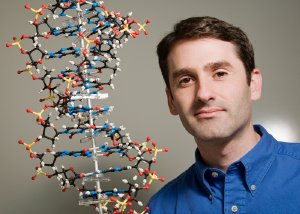Aug 16 2009
Better tools for manipulating DNA in the laboratory may soon be possible with newly discovered deoxyribozymes (catalytic DNA) capable of cleaving single-stranded DNA, researchers at the University of Illinois say.
 Better tools for manipulating DNA in the laboratory may soon be possible with newly discovered deoxyribozymes (catalytic DNA) capable of cleaving single-stranded DNA, say Scott Silverman and other researchers at the University of Illinois. Photo by L. Brian Stauffer
Better tools for manipulating DNA in the laboratory may soon be possible with newly discovered deoxyribozymes (catalytic DNA) capable of cleaving single-stranded DNA, say Scott Silverman and other researchers at the University of Illinois. Photo by L. Brian Stauffer
The deoxyribozymes accomplish the DNA cleavage with the sequence-selectivity and site-selectivity required for a practical catalyst, the researchers say.
"Our work suggests that deoxyribozymes have significant potential as sequence-specific DNA cleavage reagents," said chemistry professor Scott Silverman. "The hope is that we can take this fundamental advance and develop the ability to use DNA as a practical catalyst to cleave double-stranded DNA."
Silverman, postdoctoral research associate Madhavaiah Chandra and graduate student Amit Sachdeva report their discovery in a paper accepted for publication in Nature Chemical Biology and posted on the journal's Web site.
The researchers discovered the new deoxyribozymes while searching for artificial sequences of DNA that could cleave proteins. The newly found catalysts function in a fashion similar to restriction enzymes, although to date by cleaving only single-stranded DNA.
Restriction enzymes, which allow scientists to cut and paste portions of double-stranded DNA, are the fundamental catalysts of molecular biology.
Each restriction enzyme, however, has a limited number of DNA sequences it can cut. Consequently, only a few percent of arbitrarily chosen DNA sequences can be cut by commercially available restriction enzymes.
Like natural restriction enzymes, the new catalysts are both sequence-specific and site-specific. "This means we can target a particular sequence, and we know we will cut at only one site within that sequence," Silverman said. "By appropriately picking the recognition and enzyme regions of the catalyst, we should be able to cut many more DNA sequences than is possible with current restriction enzymes."
The new DNA catalysts require two metal ions – manganese and zinc – to carry out their catalysis, "which is intriguing, because many natural protein-based nucleases (which cleave DNA) similarly require two metal ions," Silverman said. "One or both of the metals are presumably involved in the chemical mechanism by which our DNA catalyst achieves hydrolysis of the DNA backbone."
DNA hydrolysis is a very challenging chemical reaction, much more difficult to perform than the cleavage of a strand of RNA, Silverman said. In cleaving DNA, a water molecule must be brought in for the breaking reaction to occur. Also, both the DNA and the catalyst must be arranged appropriately in three-dimensional space.
How all of this happens with the DNA catalysts is not yet clear. Silverman's research group continues to probe the structure and mechanism of the catalysts, along with identifying and characterizing catalysts with different recognition sites.
"So far, we have achieved cleavage of single-stranded DNA targets," Silverman said. "The next big step is to cleave double-stranded DNA targets."
The National Institutes of Health, the Defense Threat Reduction Agency, and the David and Lucile Packard Foundation funded the work.